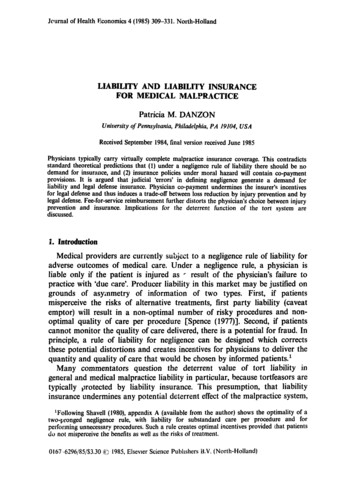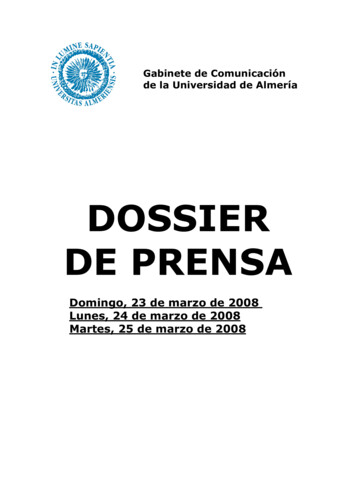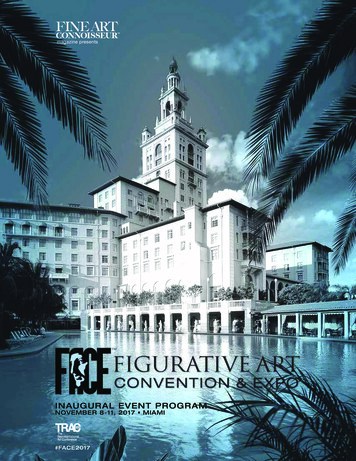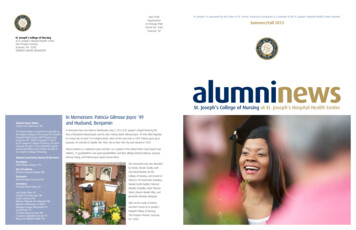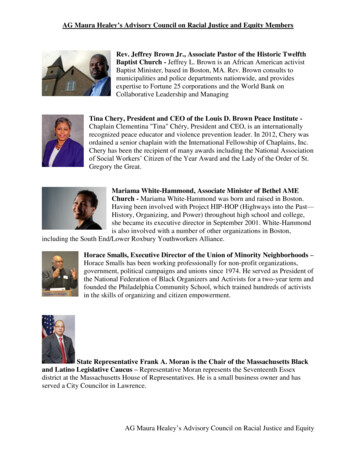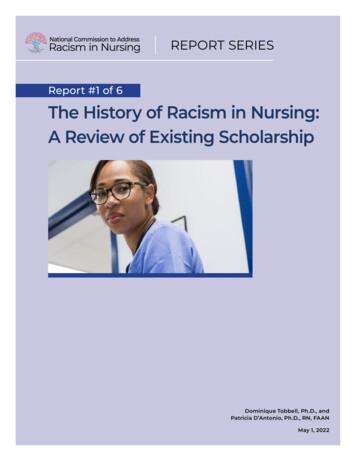
Transcription
NBER WORKING PAPER SERIESCROSS-NATIONAL EVIDENCE ON GENERIC PHARMACEUTICALS:PHARMACY VS. PHYSICIAN-DRIVEN MARKETSPatricia M. DanzonMichael F. FurukawaWorking Paper 17226http://www.nber.org/papers/w17226NATIONAL BUREAU OF ECONOMIC RESEARCH1050 Massachusetts AvenueCambridge, MA 02138July 2011Earlier versions of this paper were presented at the 2010 American Society of Health Economics meetingsand the 2009 Harvard Law School conference on Legal and Regulatory Issues in Pharmaceutical Researchand Development. This research was supported in part by the Merck Foundation Program on PharmaceuticalPolicy Issues to the University of Pennsylvania. The analysis is based on data obtained under licensefrom the IMS Health Incorporated MIDAS database. We would like to thank IMS Health and PfizerInc. for making the data available. The opinions expressed are those of the authors and do not necessarilyreflect the opinions of the research sponsors, IMS Health or the National Bureau of Economic Research.We are responsible for all conclusions and any errors.NBER working papers are circulated for discussion and comment purposes. They have not been peerreviewed or been subject to the review by the NBER Board of Directors that accompanies officialNBER publications. 2011 by Patricia M. Danzon and Michael F. Furukawa. All rights reserved. Short sections of text,not to exceed two paragraphs, may be quoted without explicit permission provided that full credit,including notice, is given to the source.
Cross-National Evidence on Generic Pharmaceuticals: Pharmacy vs. Physician-Driven MarketsPatricia M. Danzon and Michael F. FurukawaNBER Working Paper No. 17226July 2011JEL No. I11,I18,K2,L5,L65ABSTRACTThis paper examines the role of regulation and competition in generic markets. Generics offer largepotential savings to payers and consumers of pharmaceuticals. Whether the potential savings are realizeddepends on the extent of generic entry and uptake and the level of generic prices. In the U.S., the regulatory,are rea ruEic mar
I. IntroductionPharmaceutical markets in the U.S. are characterized by relatively high prices whiledrugs are on patent, followed by rapid generic entry and low generic prices once patents expire.In 2009, generics accounted for 74.5 percent of prescriptions (Berndt and Aitken, 2010) but onlyabout 20 percent of sales, because generic erosion is rapid and generic prices are low, relative tooriginator prices in the U.S. By contrast, generic penetration is slower and generic prices arehigher, both absolutely and relative to originator prices, in many other countries, implying onlymodest savings from generics for payers and patients. These modest generic savings are primafacie surprising. Post-patent entry should in theory be profitable for generic producers andappealing for customers, because generics can largely free-ride on the R&D and informationalinvestments made by originator firms, thereby realizing much lower cost structures. Expiry ofpatent barriers to entry also makes generic markets potentially more competitive than originatormarkets.This paper argues that these cross-national differences in generic shares and prices reflectdifferences in regulatory and reimbursement policies that drive countries to have eitherpharmacy-driven or physician-driven generic markets. The U.S. is a prototypical pharmacydriven generic market. Pharmacists are the key decision-maker for generics, because they arelegally authorized to substitute any substitutable (AB-rated) generic unless the physicianexplicitly requires the brand, which is rare. U.S. pharmacies have financial incentives to prefercheaper generics and brand is irrelevant for substitutable generics that by regulation are certifiedto be bioequivalent to the originator. Generics are therefore unbranded and compete on price forthe business of highly-price conscious pharmacies. Centralized purchasing by large chainpharmacies has intensified generic competition in the U.S. Tiered co-payment structures haveencouraged patients to accept generics. However, pharmacies decide which generic to dispenseand patients, payers/PBMs and physicians usually play no role in choosing one genericmanufacturer over another (except for drugs dispensed through the mail, for which the PBMsoperate their own pharmacies). The U.K. and Canada resemble the U.S. pharmacy-driven genericmodel in some respects, but with important differences, notably in Canada which regulatesgeneric prices rather than relying on competition.By contrast, the regulation/reimbursement structure for generics in many other countrieshas traditionally given less authority and fewer or even perverse incentives to pharmacies. In3
particular, substitution was only permitted if the physician prescribed by chemical name (whichis uncommon except in the U.K.), and pharmacy dispensing fees that increased with the price ofthe drug discouraged substitution of cheaper products, even if permitted. In markets wherepharmacists are either not authorized or incentivized to substitute, physicians prescribe genericsand originators by brand name and have little incentive to be price-sensitive (unless they arepersonally at risk for drug costs). Generic companies therefore market “branded generics” thatcompete on brand rather than price. Among major E.U. markets, France, Spain, Italy andGermany were traditionally physician-driven, branded generic markets. Latin America also hasphysician-driven, branded generic markets, with the added feature that many of these brandedgenerics are “similar” (have not met bioequivalence standards to the originator) and are thereforeof uncertain quality. Our basic hypothesis is that branded generics in physician-driven genericmarkets will tend to be higher priced and have lower market shares than unbranded generics inpharmacy-driven generic markets.During the 2000’s, all the major E.U. countries adopted policy changes to reduce pricesand/or increase generic uptake and thereby realize generic savings. In 1989, Germany adoptedgeneric reference pricing to encourage competition in off-patent products and expanded thesystem to include on-patent products in 2005. France, Italy and Spain adopted variants of genericreference pricing in the early 2000’s.1 Although such RP systems usually induce originators tocut prices to the RP, whether they create strong incentives for generic competition below theinitial RP depends critically on rules and incentives for pharmacy substitution. Most of thesecountries have also expanded authorization for pharmacy substitution and modified dispensingfees to incentivize generic use. Since 2007, German sickness funds have contracted directly withgeneric companies, using competitive bidding to drive price competition and capture theresulting savings for payers.Latin American markets were also traditionally physician-driven, branded genericmarkets, but with many “similares” or copy products that were launched prior to originatorpatent expiry and were not required to meet bioequivalence standards. Brazil and Mexico haveestablished regulatory frameworks to authorize true, bioequivalent generics, but many similaresremain on the market. Pharmacy substitution is usually not legally authorized in countries where1Under generic reference pricing, the payer sets a single reference price (RP) as a maximum reimbursement for allgenerically equivalent products, leaving the patient to pay any excess of the manufacturer’s price over the RP.4
generics are not required to be bioequivalent. In practice, patients often purchase drugs without aprescription, in which case pharmacists may advise on substitution. Because generic quality isuncertain, brand plays an important role in generic choice. Thus although patients generally payout-of-pocket for outpatient drugs and are presumably price sensitive, quality uncertainty leadsto competition on brand and undermines competition on price.In Japan, physicians and hospitals traditionally dispensed the drugs that they prescribedand captured any margin between a drug’s reimbursement price and its market price (oracquisition cost). Branded generics were the norm. Their incentive was to maintain thereimbursement price as high as possible, to enable discounting of the market price below thereimbursement price, to increase the margin realized by the dispensing providers. Savingsaccrued to payers only with a lag, as reimbursement prices were adjusted based on market pricesevery two years. Unbranded generics had little presence in Japan until recent reforms.This paper examines the performance of generic markets in 10 countries (the U.S., theU.K., Germany, France and Spain, Italy, Japan, Canada, Brazil and Mexico) over the period1998-2009. Our analysis draws on data from IMS Health Inc. on the universe of drug sales inthese countries. Our data permit both between-country comparison of branded vs. unbrandedgeneric markets and within-country comparison over time, to estimate effects of the policychanges. We estimate a model for three dimensions of generic markets: any entry and number ofgeneric manufacturers; generic prices, relative to baseline originator prices; and generic volumeshare. We examine how each of these dimensions of generic markets changed over time inresponse to policy changes.We also examine the effects on generic markets of originator defense strategies,specifically, launch of new licensed brand products (co-branding) or new formulations prior topatent expiry. Theory and prior evidence suggest that co-branding may be effective in physiciandriven, branded generic markets (for Italy, see Pammoli et al. 2002; for Germany, see Appelt,2009); however, such strategies are less likely to be effective in pharmacy-driven, unbrandedgenerics market. Launching new formulations prior to patent expiry on older formulations maybe a rational strategy in both market types, depending on reimbursement rules. Originatorstrategies to deter generic entry have been the focus of the E.U. Generics Inquiry.Our empirical evidence confirms that generic price competition is greater in pharmacydriven markets than in physician-driven markets, provided that pharmacies face financial5
incentives to prefer cheaper products. Branded generics, which predominate in physician-drivenmarkets, are less price competitive than unbranded generics that predominate in pharmacy-drivenmarkets, as predicted. Our results confirm previous evidence that generic entry is related tomarket size; however, differences across countries in number of generic competitors is notexplained by overall market size, plausibly because the extent of price competition, coststructures and profit margins also differ. We find little evidence that originator defense strategiesare successful on average, except that launch of delayed release formulations does deter genericpenetration in the U.S. Recent changes in generic regimes in four previously physician-driven,branded generic markets of the E.U. (Spain, France, Italy and Germany) have had significanteffects, with unbranded generics gaining share. However, these countries still lag the U.S. andU.K. in speed and extent of generic penetration.II. Generic Regulation and ReimbursementGeneric entry is constrained in all countries that are members of the World TradeOrganization (WTO) by patents and regulatory protections of innovator products. Although allWTO countries must recognize a 20-year product patent term, effective patent life forpharmaceuticals is typically shorter but differs across countries (Grabowski and Kyle, 2007).Most countries provide for some patent term restoration to compensate for time lost duringR&D, and a data exclusivity period during which generics may not reference the originator datafor regulatory approval. Patents may also be challenged prior to expiry, and this is increasinglycommon in the U.S. The originator’s effective patent life post launch is the net result of all thesefactors.Patents may be challenged in any country, but the U.S. is unique in rewarding successfulchallenges, by granting 180-day market exclusivity to the first generic to successfully challengethe originator patents (a paragraph IV certification).2 During this 180 days, the originator maymarket an authorized generic (licensed under the originator’s NDA), but no other ANDAapproved generics can enter. These paragraph IV and associated 180-day exclusivities havereportedly become increasingly common since the late 1990’s, which is expected to result in2The 1984 Waxman-Hatch Act’s Abbreviated New Drug Application (ANDA) process permits generic approvalwith evidence of bioequivalence, once the originator’s patents and other exclusivities have expired or beensuccessfully challenged.6
higher generic prices during the first two quarters post launch in the U.S. Greater use ofparagraph IV may also result in earlier generic entry over time in the U.S., unless it is offset byincreased originator use of mechanisms for patent and exclusivity extensions.In addition to patent and data exclusivity provisions, the incentives for generic entry andgeneric price competition depend on regulatory rules affecting generic competition andreimbursement, including rules government pharmacists’ authority to substitute generics;reimbursement incentives for substitution; whether generic prices are regulated or competitivelyset; and patients’ incentives to accept generics, through co-payment structures. The tiered copayment structure in the US offers patients a larger financial incentive to accept generics than inany other country.Table 1 summarizes regulatory and reimbursement characteristics of our samplecountries. This is an oversimplification of the complex regimes and changes over time in eachcountry.3 As a rough characterization, we assume that the U.S., the U.K., and Canada areprimarily pharmacy-driven generics markets, and physician-driven markets include France,Germany, Italy, and Spain at the start of our period, plus Japan, Brazil, and Mexico.Most countries implemented changes in the 2000’s. France, Germany, Italy, and Spainimplemented multiple policy changes to stimulate generic uptake and/or reduce prices. The U.K.changed its rules for setting generic reimbursement in 2005. Brazil and Mexico encouragedbioequivalence testing and the growth of unbranded generics. The U.S. experienced some growthin paragraph IV challenges, and the 2003 Medicare Modernization Act reduced the incentives fororiginators to list late patents by permitting only one 30-month stay per molecule.4 SomeCanadian provinces reduced the regulated prices on generics, and other changes were adopted in2010, after our observation period. Our empirical analysis tests for effects of these changes ineach country.III.Previous LiteratureEarly studies of generic entry and price competition focused on the U.S. Models ofnumber of entrants have consistently found that generic entry is related to market size (forexample, Scott Morton, 1999; Saha et al., 2006) and that generic prices are inversely related to3More detail is reported in an Appendix available upon request from the corresponding author.When a generic company challenges an originator patent, the originator may obtain an injunction for up to 30months or the resolution of the litigation, whichever occurs first.47
number of generic competitors in the U.S. (Grabowski and Vernon, 1992; Saha et al., 2006).Most previous studies do not address the role of pharmacies as key decision-makers in U.S.generic markets and the effects of pharmacy-driven markets on the nature of competition.Several papers (for example, Scott Morton, 2000) hypothesize that originator firms may usepromotion to deter generic penetration but find no effects. This is unsurprising in the contextwhere pharmacy substitution is the norm, such that detailing to persuade physicians to choose aparticular brand does not assure that the originator product is dispensed. In such markets,originator advertising generally declines and ultimately ceases as patent expiration approaches.5Reiffen and Ward (2005) estimate a structural model of generic entry and prices using data fromthe early 1990s.Several recent papers have examined generic uptake in other countries. Hollis (2003)reports on anti-competitive effects of strategic licensing of brand-controlled “pseudo-generics” inCanada, which are found to deter generic entry. Magazzini et al. (2004) examine generic entry inthe U.S., the U.K., Germany and France using sales data from July 1987-December 1998 onmajor molecules with patent expiry 1986-1996. Using a Tobit estimator applied to pooled paneldata for the four countries, they conclude that market share of licensed products (defined asproducts launched within 3 years of patent expiry) is negatively related to unbranded genericmarket share whereas number of different brand names has a positive effect. Possible reasons forthese apparently contradictory findings are not explored.6 Appelt (2009) provides evidence oforiginator licensing strategies prior to patent expiry and branded generics’ use of trade marks toenhance brand competition in Germany’s branded generic market. Hudson (2000) examinesgeneric entry and erosion of brand shares in four markets (U.S., U.K., Germany and Japan) usingdata from the early 1990’s which predates the more recent growth in generic erosion in the U.S.and pro-generic policy changes in other countries. Moreno-Torres et al. (2009) provide detailedevidence on generic entry in Spain. Ghislandi et al. (2005) and Garattini and Ghislandi (2006)discuss recent changes in Italy. Kanavos et al. (2008) and Puig-Junoy (2010) discuss Europeanprice regulation and its impact on generic competition.5Ellison and Ellison (2011) find weak evidence for pre-patent expiry use of promotion to deter generic entry bymedium-sized incumbents, using data from 1986-1992, which predate the growth of payer strategies to encouragepharmacy substitution and generic uptake by patients.6They regress market share of unbranded drugs on lagged market share of licensed products in an uncensored Tobitmodel that includes markets with no generics. The negative coefficient on licensed products may be dominated bythe observations with zero generic share (for which the relationship is necessarily negative), and it is unclearwhether it would hold in the subset of market with generic entry.8
Our paper adds to these previous studies by providing a consistent analysis andcomparison across 10 different countries and over a more recent time period that includesexperience after the recent reforms in several countries. Our approach is also the first to focus onthe importance of pharmacy substitution and pharmacy incentives in creating pharmacy-drivenrather than physician-driven generic markets, and the resulting distinction between competitionfocused on price vs. brand.IV.DataThe data for this study are from the IMS MIDAS database of quarterly sales of all drugsover the period 1998-2009 in 10 countries, including the major E.U. markets, two major LatinAmerican markets, the U.S., Canada and Japan. Within this universe of products, we define thesample of molecules potentially subject to generic entry as molecules with global age (yearssince first global launch of the molecule) between 8 and 20 years. This age window was selectedbased on the assumption that product patents are filed at roughly the same date in all countries,that R&D (discovery, preclinical and clinical trials, and regulatory review) typically absorbs atleast 8 of the 20 year patent term, and that most countries offer patent extensions orsupplementary protection certificates for up to 5 years to compensate for this loss.7 This agerange encompasses the ages with greatest generic entry, although entry in most countries spans alonger age range. We define the lag in generic entry of product i in country j as months from firstoriginator launch of that product in country j, recognizing that this lag may reflect legal barriersas well as economic factors.8Our analysis focuses on single molecule prescription drugs in the retail pharmacychannel. We exclude combination products, for which global age and hence generic eligibilityare ambiguous. We exclude biologics because they are ineligible for the standard abbreviatedgeneric approval procedures in the U.S. and most other countries.9 We also excludedmiscellaneous therapeutic categories (hospital solutions, diagnostic agents, various) and unusualforms (non-human use, use unknown). IMS assigns each product into one of five license7Defining products eligible for generic entry by expiry date of all listed patents is not appropriate, even if we hadthe data, because generic companies increasingly challenge listed patents prior to their expiry.8Major differences across countries in regulatory and reimbursement barriers to generic entry are described in anAppendix, which is available upon request from the corresponding author.9Abbreviated approval procedures for biosimilars have been outlined in the E.U. and U.S. in the late 2000’s.Although a few biosimilars have been launched, their higher regulatory costs and lower substitutability make themvery different from chemical generics analyzed here.9
categories: originator brand, licensee, branded generic, unbranded generic, or “Patent notassigned”.10 Our analysis is at the level of the presentation (molecule-form-strength) becausepharmacy substitution is authorized only within presentation. All price and sales data areadjusted to 2009 values using country-specific general producer price indexes (PPIs) as the bestavailable measure of input costs. Most analysis is in local currency units, but where prices areconverted to U.S. dollars we use 2009 exchange rates.Although this IMS database is more comprehensive and more detailed than the data usedin previous studies, certain limitations must be noted. First, the IMS categorization of generics asbranded or unbranded is the best available but may nevertheless be an imperfect indicator forwhether products compete primarily on brand or price. Second, the products designated asgenerics in some countries, notably Brazil and Mexico, include copy products (similares), someof which entered early in the originator life, due to lack -- or weak enforcement -- of productpatent regimes, and are not necessarily bioequivalent to the originator drug.11 Third, the IMSdata do not designate which generics have met bioequivalence tests and hence are more likely tobe considered substitutes by physicians, pharmacists and patients than those that lack abioequivalence certification. Fourth, when a merger occurs between two firms, IMS consolidatestheir separate data retroactively. Our data may therefore potentially undercount the number ofgeneric competitors, particularly in the earlier years.V.Empirical Framework and MethodsOur descriptive and regression analyses focus on the main determinants of overall genericsavings to payers: whether and when generic entry occurs; number of branded and unbrandedgeneric competitors; generic and originator prices; and generic volume shares. The analysis is atthe level of the presentation-country-quarter, defined by molecule, four-digit anatomicaltherapeutic class, formulation and strength, because pharmacy substitution of generics isauthorized only between presentations with the same molecule, formulation and strength. We10We used the corporation and molecule age to reassign products with Patent Not Assigned into branded generic orunbranded generic status.11We excluded from these calculations the small number of generic launches that reportedly occurred within 5 yearsof the originator launch, except in countries where such early launch dates are plausible due to late adoption ofpatent regimes (Brazil, Mexico, Italy, and Spain). For other countries, we reassigned the license status of theseimplausibly early generics from branded generic to licensed brand and included them as licensees in all otheranalysis. We also exclude generics for which no originator is present in any year of our data.10
estimate a four equation model for: any generic entry for the ith presentation in country j in yeart; number of generic firms, conditional on entry; generic or originator price (relative to baselineoriginator price); and generic volume share:Gijt f1 (Rijt-2; Dijt-2; Fij; Mij; Zt; u1ijt)(1)Nijt f2 (Rijt-2; Dijt-2; Fij; Mij; Zt; u2ijt)(2)Pijt g (Nijtb; Nijtu; Fij; Mij; Zt; u3ijt)(3)Sijt h (Pijt; Nijtb; Nijtu; Fij; Mij; Zt; u4ijt)(4)where Gijt is an indicator for Any Generic entrant in the presentation-country-year, Nijt is numberof generic manufacturers (branded and unbranded), conditional on entry, Pijt is normalized price(generic or originator, defined below), Sijt is generic volume share; Rijt-2 is molecule sales in thepresentation-country lagged 2 quarters; Dijt-2 is a vector of (lagged) originator defense strategies;Fij is a vector of indicators for non-oral forms; and Mij is molecule-specific characteristics. Zt is avector of indicators for two time periods, 2002-05 and 2006-09, that test for changes in thedependent variable, relative to the referent period, 1998-2001.We estimate separate regressions for each country, to permit all coefficients to vary bycountry. Other details of the estimation approach are reported in Section VI.B., with reporting ofregression results. We now discuss the rationale for included variables and their measurement:1. Any Generic (G) and Number of Generics (N)Sales (R): We postulate the same model for entry of Any Generic and Number of Generics,conditional on entry, but allow parameter estimates to differ. Following Bresnahan and Reiss(1991), Scott Morton (1999, 2000) and others, equations (1) and (2) hypothesize that any genericentry and number of generic competitors in a presentation-market depend on the market size (R,gross sales), assuming certain fixed entry cost per firm, due to regulatory and other entryrequirements that may differ across countries. Market size is measured by annual sales atmanufacturer prices in the retail and hospital channels combined, lagged two quarters.12 Costs ofentry differ by formulation (F), with higher manufacturing and regulatory costs for intravenous,topical, and other complex forms compared to simple oral solids (tablets and capsules).12The appropriate lag for the Originator sales variable depends on when generic firms make entry decisions. Ifpotential entrants accurately project market sales at the time they are likely to enter, our two quarter lagged revenuemeasure should reasonably characterize the expected relative market size that was relevant to generic decisions toundertake entry.11
Originator Defense Strategies (D): We test for effects of three potential originatordefense strategies: Number of Licensees, Number of New Originator Formulations launched justprior to patent expiry, and OTC share, all lagged two quarters. Originators may have incentivesto launch co-branded licensees to steel share and pre-empt generic competitors in physiciandriven generic markets with brand competition. Such incentives are not expected in pricecompetitive, pharmacy-driven markets such as the U.S., except for authorized generics launchedduring the Paragraph IV exclusivity period.13 Incentives to launch improved formulations, suchas extended release forms, may exist in both pharmacy and physician-driven markets, becausegeneric substitution is only permitted within a formulation. The originator’s incentive to launchnew formulations close to patent expiry of older forms is increased if the new forms receivesome additional patent or regulatory exclusivity and can be reimbursed at prices above the priceof generic versions of the older formulations. Such conditions exist in the U.S., where aggressivemarketing can successfully switch physicians/patients to the new, protected forms and awayfrom the patent-expiring form which faces generic entry. However, launching new formulationsis less likely to be profitable in countries where reference pricing or similar reimbursement ruleslimit reimbursement for all formulations of a molecule to the lowest price per daily dose for thatmolecule, which is likely to be a generic once the patent expires on any formulation in themolecule. Finally, for molecules that meet regulatory requirements for patient self-medication,originators may launch an over-the-counter (OTC) formulation to preempt generic competitionin the Rx formulation after patent expiry.Molecule Global Age, Launch Lag and Diffusion (M) and Form (F): Molecule GlobalAge (months since first launch of the molecule in any of our sample countries, hereafter “globallaunch”) is included as a proxy for unobserved patent term. The greater Molecule Global Age,the more likely that unobserved patents and other exclusivity barriers to entry have expired.Country-specific Molecule Launch Lag (months from global launch to first launch in country j)is a proxy for country-specific data exclusivities that usually run from the originator’s countryspecific launch. It is also expected to be positively associated with generic entry. Global13In the U.S., several originator firms in the early 1990’s launched their own generic products to compete with truegenerics; however this strategy simply accelerated the downward pressure on generic prices and was abandoned.Originator launch of generics in the U.S. is now confined to “authorized generics” launched during the 180-dayexclusivity period awarded to paragraph IV challengers, when prices remain high because only one ANDAapproved generic competitor is present.12
Diffusion, measured as the number of countries in our sample in which the molecule is launched,is an indicator for availability of foreign supply sources and possible economies of scale forgeneric suppliers; it is expected to be positively associated with entry. A vector of Formulationindicators (F) controls for formula
from the IMS Health Incorporated MIDAS database. We would like to thank IMS Health and Pfizer Inc. for making the data available. The opinions expressed are those of the authors and do not necessarily reflect the opinions of the research sponsors, IMS Health or the National Bureau of Economic Research.

